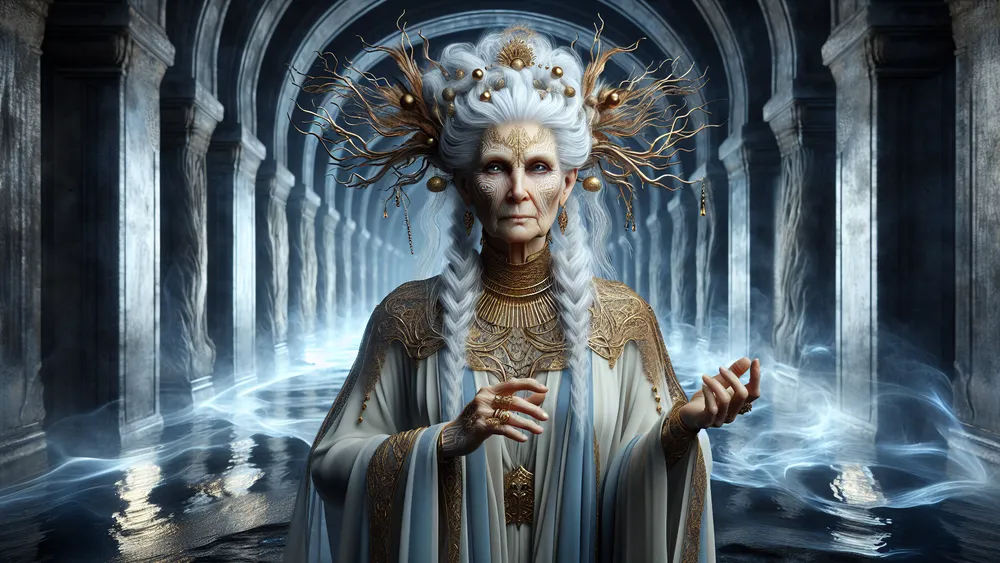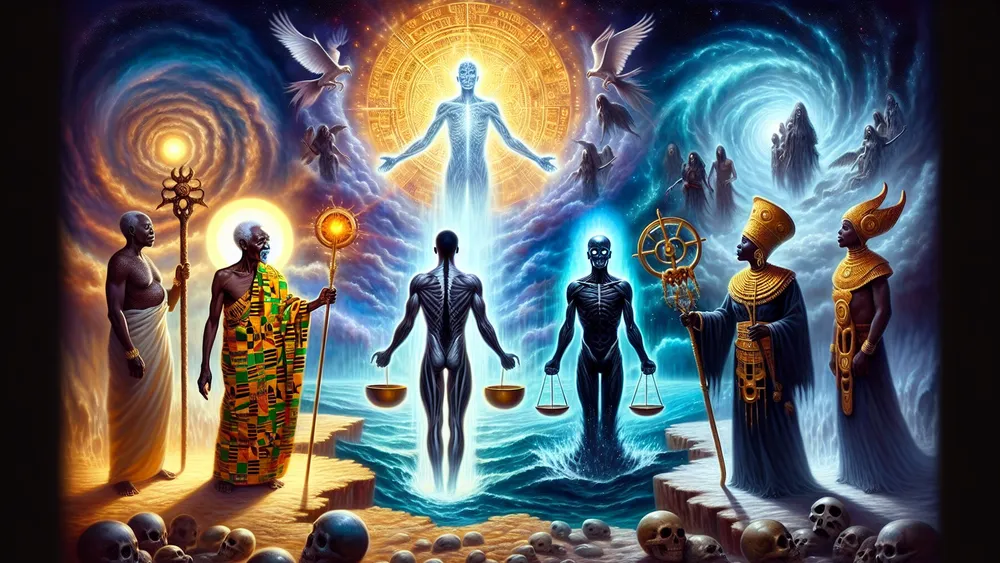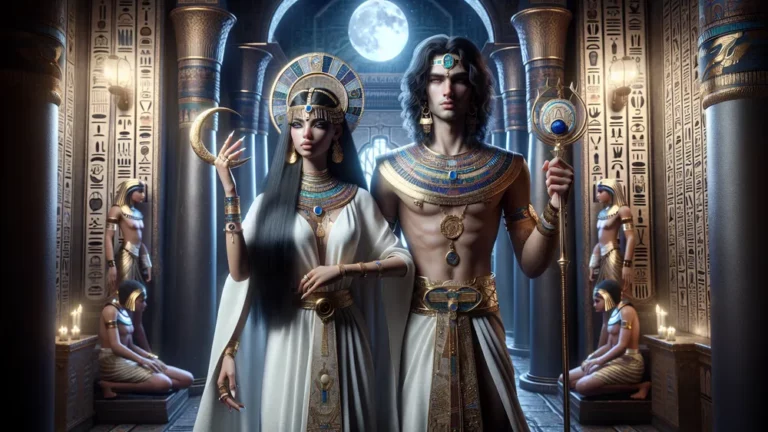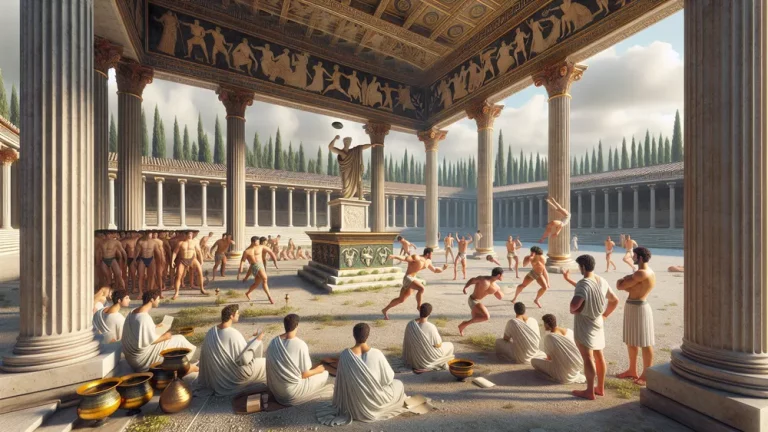Amokye: The Guardian Of The Asamando In Akan Mythology
In Akan beliefs, a soul’s path does not stop when it dies. Instead, it keeps going into the spirit world, a place where the dead must find a way inside Asamando, the place where their ancestors are. The one they first meet is Amokye, a spirit guard who decides if a soul can go in or not.
Key Points:
- Amokye is the spirit who decides if a dead person can enter Asamando, the Akan afterlife.
- A person must have the right burial customs, or Amokye will not let them in.
- If a soul is rejected, it does not disappear or go somewhere else but keeps wandering.
- The Akan believe a person stays connected to family and ancestors after death.
- People compare Amokye to underworld guardians like Charon from Greek myths, but she does not take souls across water.
- Funerals are important because they prepare the dead for Asamando and help them be accepted.
- The Akan pass down Amokye’s story by speaking, not through books or paintings.
Because of this, she is one of the most important figures in how the Akan people think about what happens after death. People compare her to Charon from Greek stories, a figure who helps souls cross the River Styx, or Anubis from Egyptian tradition, a god who checks a soul’s heart to see if it is good. Amokye, though, does not take souls across anything.
What she does is decide if they can enter, and she makes this choice based on how they were buried and if their family has accepted them. Many think of her as an old woman, though she is not a goddess or just a normal person, but something between the two.
She is between life and death, not quite part of either world. Because of this, she is in many Akan traditions, and her role makes it clear why burial traditions matter so much – if these customs are not done right, a person’s soul might be rejected. That would mean the soul has to keep moving endlessly instead of resting with their family in Asamando.
There are many stories about Amokye, and they often explain what the Akan people believe is most important: to respect traditions, to do things the right way, and to make sure a person is properly prepared before they leave this world.
Amokye: Overview and Key Facts
| Aspect | Details |
|---|---|
| What She Does | Amokye stands at the entrance to Asamando, the place where the dead go in Akan beliefs. She is the one who decides if a soul can enter. This depends on whether the right burial steps were followed and if the ancestors will accept them. |
| Where She Comes From | She is part of Akan stories, mostly among the people in Ghana and Côte d’Ivoire. |
| What She Is | People picture her as an old woman. She is not a goddess but also not just a normal person. She is the one at the entrance between life and what comes after. |
| Connection to Ancestors | In Akan traditions, a person must have the right burial customs to be with their ancestors. Amokye is the one who makes sure that only those who had their funerals done properly can join them. |
| How She Is Like Figures From Other Beliefs | Some compare her to Charon from Greek stories, who takes souls across water, or Anubis from Egyptian beliefs, who checks souls, but Amokye does not do those things. Instead, she waits at the entrance and decides who is allowed to go inside. |
| Why Funerals Matter | The Akan do certain things when a person dies – first, they wash the body, then they pour drinks as an offering, and finally they bury them properly. Without these steps, Amokye may not let the soul in. |
| What Happens to Those Who Cannot Go In | If Amokye refuses them, their souls do not rest. Instead, they wander without a place, never being with their ancestors. Some say that these lost spirits may even appear as ghosts. |
| Where These Stories Come From | People tell stories about Amokye from generation to generation. The stories do not come from written texts – instead, they are told and remembered over time. |
Amokye’s Job in Akan Myths
Amokye has a very important role in what the Akan people believe about life and death. She is the one who stands at the entrance of Asamando, the place where the ancestors are. Souls cannot enter on their own. Someone must decide. That is what she does. Before a soul can be allowed in, certain things must happen first.
The way the Akan perform funerals is one of the most important parts of this. Amokye looks at the person’s burial customs, and if everything was done the right way, only then can they join their ancestors. To understand why she matters, it is necessary to look at different things: who she is, what kind of place Asamando is, and how the customs for funerals make the journey possible.
Who is Amokye?
In Akan beliefs, there is a place where the dead go. It is called Asamando. But not everyone can simply go there. Someone must decide who can enter and who must stay outside. That person is Amokye.
People usually say she looks like an old woman, but she is not a normal human being and also not a goddess. She is one of the spirit beings who exist in between life and death. She does not live in the world of the living or fully belong with the ancestors.
Instead, she is the one who watches over the entrance to Asamando and chooses who goes in. Before someone can join their ancestors, they must have the right burial customs. If their family has not done these things properly, or if something is missing, Amokye may not let them inside. Some people think of her as someone who is strict and does not let people in if they do not meet the requirements.
People compare her to Charon from Greek myths, the one who takes souls across a river after they die. But Amokye does not move souls from one place to another. She does something else – she looks at them and makes a decision. For those she does not let in, the path forward is very different. They do not disappear, and they do not go to another place of rest.

Instead, they keep wandering, never being with their ancestors.
Amokye, a spirit being neither fully among the living nor the ancestors, stands at the entrance to Asamando, deciding who may enter based on whether the proper burial customs were followed, while those who are not accepted must roam endlessly.
What is Asamando, the Akan Afterlife?
In Akan beliefs, the dead do not simply disappear. They go to Asamando, a place where the spirits of past generations live. This is not a place where souls are judged or punished. Instead, life keeps going, just in a different way, among the ancestors. Spirits in Asamando are not completely disconnected from those who are still alive.

They still have a connection to their families, they can see what happens, and they even receive offerings from people who come after them. But not everyone who dies can enter immediately. For a spirit to join the ancestors, certain things must happen first. Their family must give them the right kind of burial, and the ones who have already passed must accept them.
If this does not happen, the soul does not find peace. Instead of staying in Asamando, they have no place to go. They wander. People who study old tales say that Asamando is similar to other beliefs about what happens after death. Hades, from Greek stories, is also a place where spirits live after they die. But there, one god is in charge of everything. In Asamando, no god rules.
The ancestors are the ones who decide. Some also compare it to the Duat, an idea from ancient Egyptian beliefs, which is a place spirits must go through before they enter the land of the dead. There, they have to pass tests before reaching Osiris. In Asamando, there are no tests. There is no judgment for being good or bad.
A person’s family and ancestors are what determine whether they can stay. This makes one thing very clear: In Akan beliefs, how well a person is connected to their family, traditions, and past generations matters even after death. A person does not stop being a part of their community just because they are gone.
Funeral Traditions and Sending Off the Dead
For the Akan, death is not just an ending. It is also a moment when something else begins. A person who dies does not simply enter Asamando right away. Certain things have to be done first. If they are not done properly, the spirit might not find peace. Because of this, funerals are not only about grieving the dead. They are about preparing the spirit for what comes next.
The people who remain behind must take care of this process. Amokye, the one who stands at the entrance of Asamando, does not just let every soul in. They must be accepted by the ancestors, and their funeral must be done in the right way. If something is missing, the spirit may not be allowed inside.
This is why funerals are important and why they last for many days, bringing many people together – not just the close family but also others in the community.
Some of the important things done during an Akan funeral include:
- Cleaning and Dressing the Body: The dead person is washed, and they are given clothes that show respect. They must be prepared properly before they can leave this world.
- Offering Libations: Alcohol or water is poured, and prayers are spoken so that the ancestors will accept the new spirit into Asamando.
- Drumming and Dancing: Music is played, and people dance. This is not only for those who are alive but also for the one who has died. It helps them on their way.
- Burial in the Right Way: The dead person must be buried as their position in life requires. If this is not done correctly, the ancestors might not accept them.
- Remembering Them After Burial: Even after the funeral, food and drinks are given in their name to keep them at peace. If this is not done, their spirit might not stay where it should.
If these steps are not followed, the dead person might not rest. Instead of going to Asamando, they remain. They do not join the ancestors. They do not disappear. They are stuck. These spirits, called “samansa,” are unable to find their place. They are neither among the living nor fully among the dead.
Because of this, Akan funerals are not just about loss. They are important actions that decide what happens to a spirit after death.
Stories and Legends About Amokye
Amokye is not just the one who watches over the entrance to Asamando. She also appears in many stories about her role. These stories help people understand what is important in Akan traditions and what happens when spirits arrive. At the entrance, Amokye speaks to the spirits of the dead. Some she allows through. Others she does not. There are also tales where things happen differently.
Some spirits trick her and enter even though they were not supposed to. In many of these stories, Amokye asks questions before allowing anyone to walk past her. In some cases, a person must answer correctly. In others, a missing funeral rite keeps them from entering. And then there are stories where someone finds a way around Amokye.
Because of this, the stories people tell about Amokye do more than talk about her role as a guardian of the entrance. They also explain what matters most in Akan beliefs.
The Brave Warrior Who Was Turned Away
A long time ago, a warrior known for his strength and victories died in battle. When his spirit reached the entrance to Asamando, he thought he would be treated like a hero. He had fought many times, protecting his people and winning battles that made his name remembered. With confidence, he stepped forward. He believed the ancestors would welcome him.

But at the entrance, Amokye did not let him pass. She told him no. The warrior was shocked. He had done so much. He had been strong, fearless, and had given everything for his people. But Amokye said none of that mattered. His spirit could not enter because his funeral rites had not been done properly.
He had died far from home, and without the right rituals, the ancestors did not accept him. The warrior begged. He said his people owed him this, that he had sacrificed everything for them. But it was not about what he had done in life.
In Akan beliefs, no person, no matter how strong, could get around the rules that controlled the passage to the afterlife. Amokye did not change her mind. Because his funeral rites had not been done, he stayed outside. His spirit had no home and could not rest. Some say his spirit did not stay silent.
In some tellings of this story, people say he came to his family in dreams, speaking to them, asking them to make the offerings that would let him enter Asamando at last. Only when this was done could he finally rest. What this myth explains is simple: What a person does in life is not enough. The right funeral rites matter more.
Even the greatest leaders, the strongest fighters, the people most remembered cannot skip these steps. Akan traditions require that every person, no matter how important, follows the same customs when it is time to go to the world of the dead.
The Woman Who Outsmarted Amokye
There is an old story about a woman who did something that almost no one else had done. She died, but she did not stay dead. She was not expecting to die. But she did. Suddenly, she was at the entrance of Asamando, and Amokye was there, just as she always was. But the woman was not ready to leave the world above.
Some say she had children. Others say she had been taken too soon. No matter the reason, she knew one thing. If she crossed into Asamando, she would never walk back. Amokye waited. The woman had to think fast. So she looked down. Her clothes. That was it. She made a small movement, then another.
She pulled at her garments, acting as if they were not fitting well. She told Amokye that someone like her, a guardian of great importance, had seen many people, but had she ever seen someone as skilled in making cloth? For a moment, Amokye waited, watching. She listened. The woman kept talking, making her voice smooth, her words polite.
Finally, she said, “Let me show you.” And Amokye allowed it. The woman moved her hands as if she were weaving. But she was also moving, slowly, step by step. She went closer to the world of the living. Waiting. Moving. Almost there. And then, at the right moment, she turned and ran. Before Amokye could stop her, she was gone.
This story helps people see what is important in Akan beliefs. The warrior who arrived at the entrance with bravery was not allowed to pass. But this woman, who had no great strength, was different. She had something else – quick thinking. And because she was able to use her mind, she went back.
In Akan beliefs, being clever matters more than being strong, as shown by the woman who escaped death not with force but by thinking fast.
What Happens When a Soul Meets Amokye?
When a soul reaches the entrance of Asamando, it does not move forward right away. First, it faces Amokye. She stands where the world of the dead begins. And she waits. The path is not open to everyone. A soul must be ready.

Some say there is a river between the two worlds, while others think of it as a gate. Whatever the case, the rule is clear: Amokye is the one who decides. She looks at each soul and checks if everything is as it should be. A person must have had the right burial rites. The family must have done their part. Sometimes, Amokye asks questions.
Did the living honor this person? Was everything done correctly? Were they someone the ancestors will accept? If the answers are right, she lets them pass. Then, they join the ancestors. But not all souls are accepted. If the burial was not done properly, or if something was left unfinished in life, there is no way forward.
These souls are not allowed inside. They do not return to life, and they do not reach the ancestors. Instead, they must remain outside, unable to move forward. Some people say this is like what happens in other places. The Greek myth of Charon tells of a man who takes souls across a river, but only if they were buried a certain way. Yet Amokye is different.
She does more than take souls across – she decides whether they can enter at all. This helps people see how much Akan beliefs focus on family and community. A person is not judged only by what they did alone. Their place in the next world also depends on those still living, on what they do to prepare them, and how they send them forward.
How Amokye is Imagined and Remembered
Amokye is important because she helps souls reach the next world. Yet, people do not make many drawings or sculptures of her. Some gods and spirits have statues. Books are written about them. Temples hold their images. But Amokye? No one makes these things for her very often. But she is not forgotten. People still tell her story.
She is remembered in a different way – through oral traditions, through what elders tell the young, and through beliefs that continue from one generation to the next. Some tell her story with words alone, never writing them down. And because of that, she remains.
Amokye in Akan Storytelling
Akan people mostly keep their stories by speaking, not writing. That is how the story of Amokye stays alive. Instead of books or holy texts, words are passed between one person and another. In many places, the elders, storytellers, and priests tell about her. They explain what she does. She stands at the entrance of Asamando, making sure the right souls may go forward.
By telling her story, they help younger people understand why burial customs must be done properly and what happens after death. Some gods have people who worship them. But Amokye is different. She is not really thought of as a god. She does not have temples. People do not pray to her. In certain stories, she is an old woman who watches over the dead. She asks them questions.
She listens to their answers. This makes her role as a guardian clear – she is there to keep order, not to act as a god. The way people keep her story matches a larger pattern. Many West African traditions use spoken words to keep history, rules, and beliefs from being lost.
This is why people still talk about Anansi and other folk spirits, even though there are no old religious books about them. Amokye, too, remains.
What Does Amokye Look Like?
Some Akan gods and royal ancestors are often shown in carvings or on cloth. But Amokye? She is not. Akan artists do not make many pictures of her. They do not carve her face from wood. They do not paint her image. In most traditional Akan art, she is not there. But this is not unusual. Many spiritual figures in West African culture are not drawn as people.
Instead, they are represented in other ways. Shapes. Patterns. Symbols. These stand for bigger things, like the afterlife. Instead of making a picture of Amokye, Akan artists use symbols that mean something about death and what comes after it.
Objects used in funerals might include carvings or designs related to the movement of souls. Her face may not be there, but the ideas connected to her still are. The same thing happens with Nyame, the Supreme God. People do not make pictures of him. Instead, they show him with symbols of the sky or other religious objects.
This fits with how Akan spirituality is mostly passed through spoken words, not images. People do not need a picture of Amokye. They keep her in stories. And in that way, she remains.
Amokye vs. Other Guardians of the Afterlife
Amokye is not the only spirit that watches over the dead. In different places in Africa, people believe in different spirits or gods that control who can pass from life to the next world. Each one has a job, and none are exactly the same. For example, in Yorùbá mythology, there is Buruku. A dark power.
A force connected to death and bad luck. Some say he leads souls to the other side, but not everyone agrees on what he does. Then there is Kalunga, from the Kongo tradition. He is not a person or a god. He is the thing that separates life and death. An ocean. A barrier. A space between two worlds.
Anubis? He is different. In Ancient Egypt, he was the god of preparing the dead. He judged them. He got them ready for eternity. He did not just guard an entrance like Amokye. Each of these figures comes from a different tradition, which changes how people think about death. Some speak of judgment. Others talk about walls between worlds.
The table below gives a simple comparison of these spirits:
| Mythological Figure | Culture/Region | Role in Afterlife | Key Characteristics |
|---|---|---|---|
| Amokye | Akan (Ghana) | Guardian of Asamando | Decides if souls may enter; often an old woman |
| Buruku | Yoruba (Nigeria, Benin) | Dark force of the afterlife | Sometimes linked to death, misfortune |
| Kalunga | Kongo (Central Africa) | Separation between life and death | Seen as an ocean, not a person |
| Anubis | Ancient Egypt | God of mummification | Judges and prepares the dead |
Each of these spirits affects how their people think about what happens after one dies. Amokye stands at the gate, deciding who goes forward. Others have different roles – watching, judging, or keeping a barrier between worlds.

Different African cultures believe in various spirits that guide, judge, or separate the dead from the living, each shaping how people see the afterlife.
The Pantheon of Akan Mythology
In Akan beliefs, there are many gods, spirits, and other powers that control different parts of life and the world. Some have power over nature, others over people, and some decide what happens after death. Each plays a part.
At the highest level, there is Nyame. He rules everything, and people connect him to the sky and great power. Then comes Asase Yaa, the earth goddess. She is linked to fertility and farming. And Anansi? A trickster. Clever. Always coming up with ways to win. There is no single book that explains all these beliefs. No fixed laws.
Instead, people keep them alive by telling stories, practicing rituals, and using sacred symbols. Amokye, who watches over the dead and decides who can enter Asamando, is part of this larger system. She does not rule over everything, but her role is still important. Beyond Akan traditions, other African cultures have their own gods. To see more, visit this full list with all African Gods.
FAQs
1. How does Amokye decide who enters Asamando?
Amokye decides who enters Asamando based on whether the deceased received proper burial rites and ancestral approval.
2. What happens to those who are denied entry by Amokye?
Those who are denied entry by Amokye are believed to become wandering spirits, unable to join their ancestors in Asamando.
3. Is Amokye considered a goddess or just a spirit?
Amokye is generally considered a spirit rather than a goddess, as she functions as a guardian of the afterlife rather than a deity with a broader domain of worship.
4. What are the similarities between Amokye and other mythological underworld guardians?
The similarities between Amokye and other mythological underworld guardians lie in their role as gatekeepers who judge and control access to the afterlife, much like Charon in Greek mythology or Anubis in Egyptian mythology.






